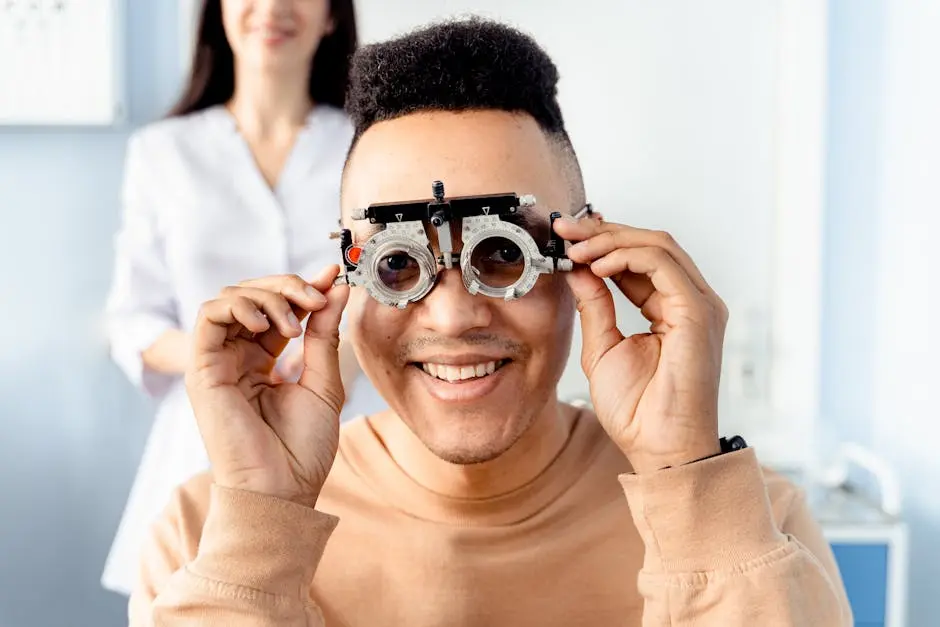
Eye exams can seem daunting if you don’t know what to expect. However, understanding the process can make it easier and less stressful. In this blog, we’ll walk you through each step of an eye exam to help demystify the experience.
Why Regular Eye Exams Are Important
Regular eye exams are crucial in maintaining good eye health and early detection of potential issues. They can help identify conditions such as glaucoma, cataracts, and macular degeneration before symptoms arise.
It’s not just about finding new glasses or updating your prescription. Regular check-ups can reveal a lot about overall health. For instance, diseases like diabetes and hypertension can sometimes be detected through an eye exam before symptoms appear elsewhere in the body. Early detection can lead to better management and treatment outcomes, ensuring that potential health concerns are addressed promptly. So, it’s not only about clear vision but also about keeping an eye on your comprehensive health.
Apart from detecting systemic diseases early, regular eye exams can significantly enhance the quality of life. Improved vision impacts daily activities, from reading to driving, ensuring you can perform tasks with ease and safety. Furthermore, as technology usage increases, regular testing helps prevent digital eye strain by updating prescriptions to meet the demands of screen time. This holistic approach ensures eye health contributes positively to overall well-being.
Preparing for Your Eye Exam: What to Bring and Wear
Before your eye exam, gather any necessary documents like insurance information and a list of current medications. Wear comfortable clothing and avoid eye makeup to ensure an unobstructed exam.
Another crucial aspect of preparation is knowing your family medical history, particularly concerning eye health. Conditions like glaucoma or macular degeneration can be hereditary, so informing your optometrist can guide a more targeted examination. Additionally, make a list of any vision-related questions or concerns—a proactive approach can make the most of your consultation. Being well-prepared not only saves time but ensures that your exam is comprehensive and tailored to your specific needs.
Remember to prepare for potential dilation. Eye drops used during the exam might cause temporary light sensitivity and blurred vision, so bring sunglasses for after your appointment. This preparation ensures comfort throughout the day and minimizes the disruption that dilation might cause. Overall, a little preparation goes a long way in enhancing the effectiveness and comfort of your eye exam.
The Basics of a Standard Eye Examination
A typical eye exam includes several tests such as visual acuity, pupil response, and eye muscle movement. Your optometrist will assess these to evaluate your vision and overall eye health.
Visual acuity tests determine how well you can see at various distances, using a standardized eye chart. This foundational test uncovers clarity levels and determines if corrective lenses are necessary. Pupil response tests measure how your eyes react to light and darkness—a crucial indicator of neurological health. Similarly, assessing eye muscle movement checks the alignment and teamwork of your eyes, impacting depth perception and focus. Combined, these tests provide a holistic insight into your visual abilities and overall eye health.
Beyond these core tests, comprehensive exams often include evaluations of color vision and depth perception. Color vision tests can identify deficiencies that might not be apparent in daily life but are crucial for certain occupational tasks. Depth perception checks ensure your eyes work in tandem to correctly perceive the world in three dimensions, crucial for activities like driving or sports. Together, these elements offer a thorough understanding of your visual profile and inform any necessary corrective measures.
Specialized Tests You Might Encounter
During an eye exam, you may encounter specialized tests like refraction assessment and retinal imaging, which help in determining prescription lenses and checking the health of the retina.
Refraction assessments pinpoint the exact prescription needed for eyeglasses or contact lenses. This precise measurement ensures the best possible vision correction for nearsightedness, farsightedness, or astigmatism. Retinal imaging, on the other hand, provides a high-definition view of the retina and optic nerve. This advanced technology aids in the early detection of retinal disorders and systemic diseases, enhancing the care strategy for your eyes. Embracing these specialized tests equips you with comprehensive insights into your eye health.
Intraocular pressure measurement is another specialized test you might encounter, mostly associated with glaucoma screening. Elevated pressure inside the eye can indicate glaucoma, a serious condition that, if left untreated, can lead to vision loss. By monitoring intraocular pressure, optometrists can identify early signs, enabling timely intervention to preserve vision. Special tests may seem daunting, but they’re vital for providing a detailed understanding and ensuring long-term eye health.
Interpreting Your Eye Exam Results
Your optometrist will explain the results of your eye exam, discuss any findings, and provide recommendations for corrective lenses or additional tests if necessary.
Interpreting eye exam results can be intriguing and insightful. You will learn whether there are changes in your vision, requiring prescription updates, and you’ll get a clear picture of your eye health. Understanding terms like 20⁄20 vision or specific lens prescriptions can demystify your results. Engaging with these insights empowers you to make informed decisions about corrective measures and lifestyle adjustments to support visual health.
Optometrists often provide lifestyle recommendations based on your results, such as limiting screen time or adopting better lighting for workspaces. These suggestions are aimed at preserving and enhancing your vision quality. By understanding the impact of daily habits on eye health, you can prevent issues related to eye strain or fatigue. Thus, interpreting results isn’t just about numbers on a page; it’s about translating them into actionable steps for maintaining optimum vision.
Making Eye Exams a Part of Your Health Routine
By knowing what to expect, an eye exam becomes a routine and stress-free experience. Regular eye checkups are crucial for maintaining eye health and catching potential issues early. So, embrace the eye exam as a key part of your overall health routine and see it more as a friend than a foe.

